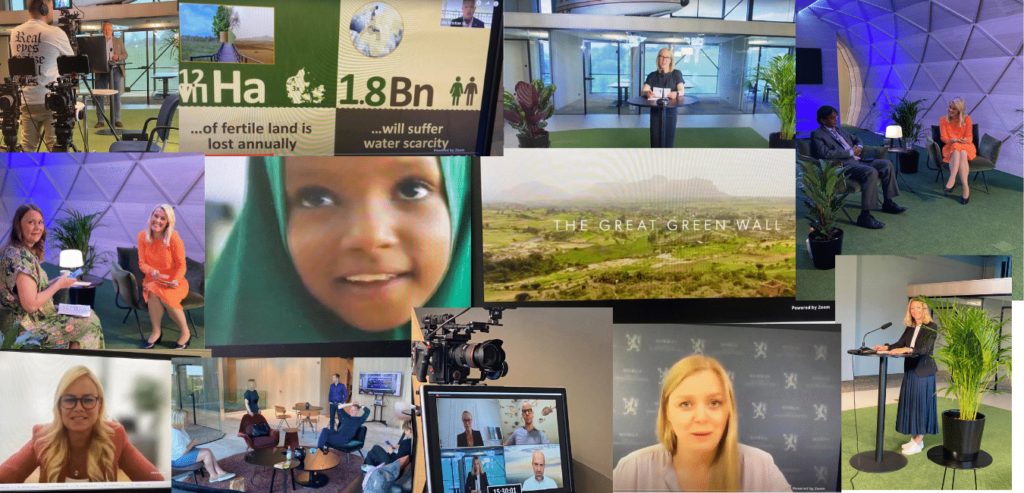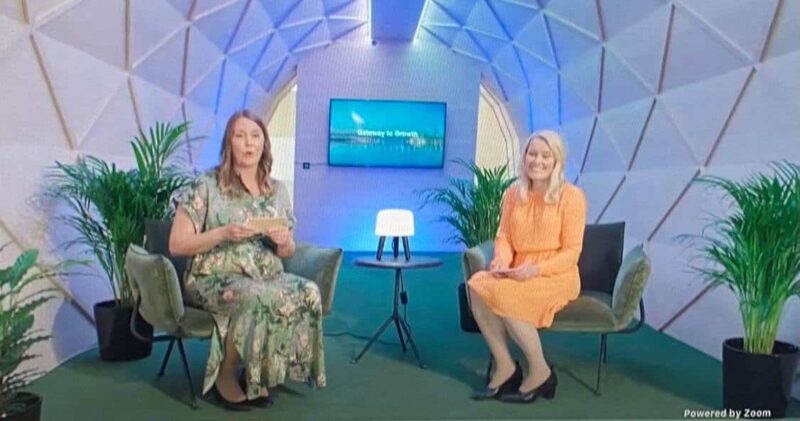With a 3 hour digital conference, 25 speakers and 300 participants the project “Gateway to Growth” was kicked off 2. of June! Here you can read the summary and watch the conference in recording. You can find the time for your favorite sections and speakers in the article.
Photo credits: Hege Forus and Anne Marie Lofthus
With a 3 hour digital conference, 25 speakers and 300 participants the project “Gateway to Growth” was kicked off in great style with opening speech and welcome from both Minister of Petroleum and Energy, Tina Bru and our own County Mayor of Rogaland, Marianne Chesak. Gateway to Growth is a result of a joint ambition to support the realization of the energy transition and technology development in our region and to demonstrate that our products and solution may have global impact. The partners behind the conference; Klimapartnere Rogaland, Beyonder, Siemens, Advansia, Law firm Thommessen and TOOL are happy to finally have kicked off the project, and are continuing the work and focus to grow «Gateway to Growth».
Minister of petroleum and energy, Tina Bru started out by thanking the team of Gateway to Growth and that she wished she could be together with us in her home county Rogaland. She said the conference was a great opportunity to speak about the links between climate, energy and industry. She mentioned that Norway is well positioned to increase market shares globally especially for energy related industries.
Following the minister, our mayor of Rogaland, Marianne Chesak kicked-off “Gateway to Growth”. She said she was excited to see this project unfolding and said it could be the starting point to accelerate high potential technologies and energy solutions from Rogaland to impact the global market. She emphasized that it is important for her to support the businesses we would hear from during the day, as this is creating new workplaces and make our region relevant and attractive both for students and families to settle down here. She continued by saying that we need to work together to realize the opportunities ahead of us and that we need more of these arenas in the future to enhance our position as an active and a commercially viable region. (Video: 00:03:15)
Norways role in the green transition – where are we heading?
Liv Monica Stubholt from law firm Selmer was the host of the next session “Norway and Rogalands role in the green transition”. We were introduced to a great panel; Hege Kverneland from Kverneland Energy and Desert Control, Gaute Hagerup from C40 Oslo and Head of Economic Development and International Affairs in Stavanger municipality, Anne Woie. They discussed how we as a region can transform from oil and gas industry and engineering to work on renewable energy and sustainable technologies required in the future. It was stated that engineers are extremely adaptive and that oil and gas technology is very high tech. Also Norwegian engineers are very stubborn, innovative and love challenges – therefor with the competence, technology and willingness to adapt we have a great base for the transition we need in reducing greenhouse gas emissions from several different industries and also technology for reducing CO2 emissions with carbon capture technology. We also need to collaborate better and smarter within the region and between regions. (Video: 00:14:50)
The great green wall, Sahel in Africa
For many, one of the highlights of the day was hearing about the opportunities that lies in the $17 billion project “The Great Green Wall” presented by Camilla Nordheim-Larsen from UNCCD (United Nations Convention to Combat Desertification).
The session opened with a clip from the movie “The great green wall” produced by Jared P. Scott.
Nordheim-Larsen gave us a background for the project and how the growth of and build up of this green wall will transform the lives of millions of people on the frontline of climate change, and once finished will be the largest living structure on earth – 3 times the length of Great Barrier Reef! It’s a wall, not to divide people, but bring people together across a continent. And as she put it “A global symbol of hope for our common humanity and an urgent nature-based solution for the planet”. And with a difficult situation today for the millions of the inhabitants of this region including, drought, unemployment,war and thus an increasing number of refugees, the project also brings hope for a better future and opportunities. To be able to do this they need cutting edge solutions, energy and technologies when looking to restore 100 million hectares of degraded land, sequester 250 million tonnes of carbon and create 10 million jobs in rural areas. The Great Green Wall contributes to 15 of the 17 SDGs.
The key areas and sectors where investments are being prioritized are solutions and technologies for climate resilitent infrastructure and renewable energy, remote sensing / satellite imagery, farm development, sustainable value chains and export markets and regenerative food solutions among other things. She ended by saying how UNCCD project group are working as “match makers” between solutions and investors. (Video: 00:41:50)
CEO from Desert Control, Ole Kristian Sivertsen fittingly started out pitching after the presentation from Nordheim-Larsen. He was followed by Øyvind Vesterdal from Norsk Solar, Hege Kverneland from Kverneland Energy, Svein Kvernstuen from Beyonder, Knut Roar Wiig from Nordic Unmanned and Thomas Flinskau from Integrate Renewables. Please check out the links for their presentations. (Video: 00:54:20).
How to spark great conversations on sustainability
During the break we presented great up and coming local artists from the region that we believe could have international potential. They provided us with that goosebump effect and local pride (Video: 01:16:50) and was a great intro to a softer subject, – why it is important to spark conversations on sustainability by founder of the popular and much talked about “Fuelbox”, Berta Lende Røed. We got insights into why Lende-Røed started the company. From those important conversations with her husband, she created the tool Fuelbox. First to ignite curiosity. Because one small question can make a big difference and how that curiosity is a superpower! Then she discovered that there were other arenas that needed to be happy, engage, perform better and release collective potential in the organization together! Now her team of 7 work with governments and companies from all over the world. We learned how teams and organisations need to engage all employees in order to create trust and psychological safety which is the foundation of collaboration and innovation which is crucial in the green shift. She empazised how the transition on sustainability and green transition is not a “one man show”. We need to come together like the event today “Gateway to Growth” and start sharing and learning from eachother to find new solutions and seize opportunities.
“Those who cannot change their mind cannot change anything”
Berta Lende-Røed ended by saying she was proud of this project and how we need to feel connection and to feel like we are part of something bigger, that we matter and that we can make a change. With those inspiring words we felt invigorated and ready for the rest of the afternoon with inspiring speakers and company presentations. (Video: 01:29:10)
From «dirty» to clean: How fast are the green investment markets changing?
For the finance section of the day Head of Climate and Sustainable Finance in SEB, Susanne Gløersen introduced with a presentation. She also facilitated a conversation on green investment markets with Ingvild Meland from Nysnø, local investor Tore Gjedebo from Investore and Ivar Slengesol from Export Credit Norway.
Gløersen started the presentation by showing how green and sustainable investments have increased rapidly in 2021 with 180% up since last quarter 2020.
Companies and investors now look at what will give a competitive edge for the future. All major investors globally have committed to sustainable investments and several have signed up to have net zero portfolios within 2050, which is a few years ahead but it really gives us a clue on where we are heading and that those “last” to take action in the transformation will be loosing investments and opportunities in the future. Gløersen also mentioned combination of growth markets looking for new solutions and technology, and that “megatrends” will drive the investments in the green and sustainable market both within existing renewable energy and new disruptive technology. The IEA report also emphasizes the importance of funding for new green and sustainable innovations and early stages funding for rapid scaling and disruptive technologies not yet invented.
During the conversation Meland from Nysnø pointed out the resources and potential that we have in Norway and our region for green transition and in R&D and invesetment markets. Slengesol from Export Credit Norway put things into perspective with looking back to a report from the Energy Council in 2008 when they pointed out that Norway had to make some clear targets for the energy transition for 2020-2025. Other countries set these intentions and targets much earlier. Now we know that by 2025 we have installed capacity from offshore wind parks producing around 100 Megawatts, mainly from Hywind Tampen. Globally there will be 100.000 megawatt installed which means that Norway will have 0,1% of the global offshore wind market by 2025. The supply industry for oil and and gas was in 2019, 36 times higher for offshore wind compared to supply companies within oil and gas. Slengesol then said that Norway need a much clearer and bold export strategy and targets for building new green value chains. Gjedebo commented that we have seen that the oil and gas industry has looked upon the green shift as a “threat” to the industry, but that this now is changing, and that going forward we must view the green transition as a possibility and that this trend also is supported by the recent IEA report and what we have seen in the investment market during 2021. Are we able to adapt and move quickly to have that competitive edge going forward? And how can we help startups and scaleups in our region. We need an ecosystem to help over a long time and connect with international markets. Also we need the competence and «know-how» from the oil and gas industry with their willingness to adapt and transform to position ourself and grow as a region. (Video: 01:41:40)
Energy transition and sustainability focus in India
For our second section of presentations and speakers we were so fortunate to have Indias ambassador to Norway from India, Dr. Bala Bhaskar with us for an armchair with COO from Beyonder, Kristin Skofteland. Followed by Grieg Seafood presentation on sustainability within farm fish industry by Liv Marit Årseth.
Dr. Bhaskar is working very diligently to connect the norwegian and indian markets. Skofteland started out by thanking the ambassador personally for the work and the opportunities that he has opened for Beyonder in India. She then asked how India with its rising population work with energy transition and sustanability goals. Dr. Bhaskar explained a bit about Indias energy system for production and transport. Today Indias energy mainly come from coal, but still produces 90.000 MW renewable energy. In the next five years they plan to scale up energy production to 680.000 MW. Of this they want to change the energy mix so that within 2026, 220.000 MW should come from renewable energy. Dr. Bhaskar says that we should see how this present opportunities for the renewable sector and technologies. He also stress that India is looking to collaborate with markets with high end technology and focus on R&D. Norway and India are thus a good match with the interesting companies we have here together with our focus on R&D and fasilitating for testing, mentioned earlier by Head of Economoic and International Affairs in Stavanger Municipality, Anne Woie. Also for the transport market they look towards electric cars and machines and this is how they have connected with Beyonder for the capabilities of the batteries that Beyonder produces. He urged Norwegian companies to reach out more to the Indian market and look at cost effective operations and how they can scale up for a market the size of India. Indian companies are also looking to collaborate globally so there are possibilities for collaborations between startups and companies between the countries (Indian start up ecosystem is the 3 largest in the world). Skofteland ended with asking if the ambassador had any suggestions for how norwegian companies should proceed on connecting with Indian market and the opportunities there. Dr. Bhaskar said they should reach out to the Indian embassy or to the Norwegian Ambassador in India. We also would like to add that connecting with Innovation Norway might be a good starting point. (Video: 02:08:00)
How can farmed fish secure enough food for our growing population?
Liv Marit Årseth presented Grieg Seafoods ambition and goals on sustainability. Grieg is one of the larges fish farm producers in the world of Atlantic salmon with a production 87.000 tonnes last year. As the global population is growing towards 10 billion people in 2050, we require more production of food. And as the wildfish stock is limited we need to produce farmed fish. Salmon provides a nutrient dense food. Also the production of farm raised salmon requires much less carbon footprint and land than other animal proteins and is a more efficient use of feed resources. But of course there are still challenges in the industry that needs to be addressed and handled. Årseth explained how they worked on among improving the following: ensuring co-existence with nature and other species, improving fish health, finding sustainable feed ingredients, cutting CO2 emissions, recycling resources and protecting human rights. (Video: 02:28:00)
After the conversation with the Ambassador and the presentation from Grieg we had interesting presentation from Tor Magne Madsen from FishGLOBE, Sjur Usken from ClevAir, Egil Thomas Andersen from PaleBlue and Brage Johansen from Heimdall Power. (Video: 02:19:25)
We need an energy transition, and we will export it
Ivar Slengesol from Export Credit Norway came to tell us about the situation on export for Norway today. He started out by saying that there is a race internationally to build the future green industries. Both for battling the climate crisis and for the export opportunities that lies herein. Looking at the trade balance in Norway is quite eye opening. The numbers for trade balance which had its peak in 2008 are rapidly declining with it being negative for the first time since the 80s in 2020. The numbers include oil and gas. Another indicator is the marketshare. Slengesol showed us a chart with many countries where we preferably would be over the yellow line which indicate that our marketshares are growing. Emerging countries are naturally growing faster, but what is worrysome is that we are loosing global marketshares to our neighbouring countries in Europe and in the Nordics. Norways export industries are dominated by the “big four”: oil and gas, maritime and offshore, power related industry and seafood. We need to build scalability for the smaller industries to increase export credit. Rogaland is an export region being number 4 behind Vestland, Oslo and Viken and he mentioned especially the companies we already heard from throughout the day and the opportunities they provide for growth within the green industries. On a positive note Slengesol is hopeful for Norway and that we have the ability to turn the trend, and that we already see signs for the market to turn to greener industries with more growth potential for the future. He specifically mentioned transitions in companies as Equinor with offshore wind and Aibel on the supply side now with 40% of their jobs being within the green industry (We also now know about the bolder strategy from Equinor towards 2050). Slengesol ended his presentation with six export boosting actions: Bold and measurable export strategy, a new governance structure, prioritize selected value chains, concrete sector deals to plan, follow up and deliver, a revamped public support system and new flexible solutions that meet market demand. (Video: 02:46:30).
Empowering Generation Cleanup – The Global Map uniting Innovators
Birgit Marie Liodden from The ocean opportunity lab (TOOL) is an entrepreneur and a connector. Liodden told us how TOOL aims to support the evolution of emission & waste free ocean industries through optimizing the next generations ability and interest in leading and creating change. The tool that TOOL now are launching is called TOOL spawn which will close the gap between entrepreneurs, changemakers and investors. TOOL Spawn is like “Tinder” for changemakers within the ocean and renewable energy market, and is based on the “pay it forward” mentality. We hope some of the companies and attendants for Gateway to Growth will find the tool useful and there is an early adapter onboarding period before the global launch within 3oth of June. You can read more and contact TOOL here. (Video: 02:54:00).


